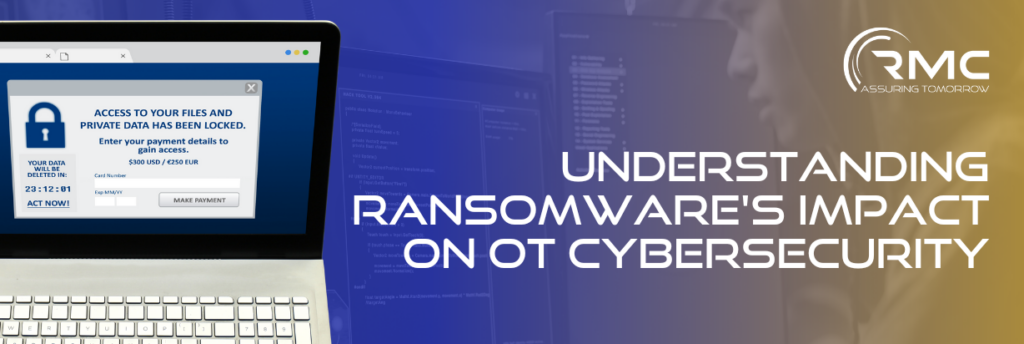Vince Kuchar, CEO of RMC Global, & Brad Bekampis, Senior Cybersecurity Specialist
Ransomware, a formidable adversary in the cyber landscape, presents unique challenges to Operational Technology (OT) environments.
This digital scourge not only impedes operations but also imperils critical safety practices and the efficient functioning of key industrial systems.
OT environments often find themselves inadvertently in the ransomware crosshairs. Although certain nation-state level groups might deliberately target OT systems for geopolitical reasons, most ransomware groups are indiscriminate in their attacks. Their primary objective is financial gain, leading them to target schools, hospitals, government facilities, and more, without specific malice toward the nature of these institutions.
This is compounded by the inherent vulnerabilities in OT environments, where unsupported legacy systems that have passed their end-of-life abound. This indiscriminate targeting underscores the fact that many sectors including healthcare and manufacturing become victims not because of their specific functions but due to the inherent susceptibilities in their technology environments.
Understanding the motives of ransomware groups is vital for shaping effective cybersecurity strategies in OT environments and reveals the importance of developing comprehensive defenses to thwart these opportunistic actors. Our in-depth exploration today focuses on the complexities of ransomware attacks, their diverse impacts across OT, and the essential strategies for a robust cyber defense.
The Varied Faces of Ransomware in OT
Ransomware’s impact on OT environments is complex, multifaceted, and requires a nuanced understanding. The RMC security team often begins engagements by asking our clients what their ‘bad day’ in OT looks like. Because no two organizations are alike, each one answers differently. For some, a ‘bad day’ in OT might involve complete system shutdowns, halted production processes, severe operational disruptions, or worse.
In the manufacturing sector, the consequences of an attack can be more than just a hiccup in production. While some plants may have the capability to switch to manual operations to maintain some level of productivity, the implications can still be significant and far reaching. For them, an attack might not pose immediate human safety risks, but it could lead to losses like product spillage or misprocessing, impacting operations and revenue streams.
In sectors like healthcare, where human lives are on the line, the stakes are indeed higher. Critical system disruptions can have dire consequences, extending far beyond project delays or compromised patient data. A malware attack in a healthcare setting could necessitate the emergency transfer of patients, particularly when critical patient data becomes inaccessible, or prolonged equipment or internet outages occur. Such scenarios not only disrupt care but also endanger lives, making a swift and effective response to ransomware attacks crucial for any healthcare organization.
Whatever that ‘bad day’ ultimately looks like, it must always be considered with the worst-case scenario in mind. These situations illustrate the potential for ransomware to affect not just the targeted systems but also the essential services and people reliant on them. Whether in manufacturing or healthcare, the need for robust and sector-relevant cybersecurity measures is evident, underscoring the diverse challenges ransomware presents across various OT environments.
Ransomware’s Technical Grip on OT
Ransomware’s ability to exploit unpatched legacy systems and outdated protocols is a prevalent issue in many OT environments. A prime example of this is the 2017 WannaCry ransomware attack, which leveraged the EternalBlue (MS17-010) exploit. EternalBlue targeted the SMBv1 protocol which is in widespread use within OT networks. This exploit was dangerous for several reasons:
- Exploitation of SMBv1 Protocol: While dated, the SMBv1 protocol remains widely used in OT environments, making them particularly susceptible to this type of attack.
- Unauthenticated Remote Code Execution: The self-replicating exploit allowed for unauthenticated, remote code execution (RCE) with elevated privileges. This meant the attack did not need credentials to execute the malware, needing only network access to the vulnerable SMBv1 protocol. This capability enabled the ransomware to spread rapidly across networks.
- Missed Security Patches in OT Environments: OT environments often lag in applying security patches due to various constraints such as vendor or budget limitations. This lag continues to leave numerous systems vulnerable to the WannaCry attack.
- Lack of IT/OT Network Segmentation: A significant factor in the spread of WannaCry within OT networks was the lack of adequate segmentation between IT and OT systems. The interconnectedness of many of these networks allowed the ransomware to move from IT environments, where it typically entered, into OT systems, exacerbating the extent of the disruption.
The WannaCry incident thus exposed critical lapses in cybersecurity practices, in particular the failure to apply timely patches and effectively segment IT and OT networks. It highlighted the urgent need for updated security protocols and sound network architectures capable of defending against such sophisticated threats.
However, addressing ransomware challenges in OT environments goes beyond technological fixes. A holistic strategy is essential, encompassing not just technology but also the people and processes involved. This means educating personnel, ensuring regular vendor approved updates, implementing network segmentation, and maintaining stringent access controls. Acknowledging and addressing the interconnected nature of IT and OT systems is vital to prevent vulnerabilities in one from compromising the other. This in-depth approach forms the cornerstone of a resilient defense, emphasizing the importance of continuous vigilance and proactive cybersecurity measures to safeguard OT environments.
Forging a Path to Resilience
Building resilience against ransomware in OT environments demands a multifaceted approach, blending technological solutions with a culture of cybersecurity awareness and proactive preparedness. Key to this journey is the implementation of regular risk assessments and the deployment of proactive security measures tailored to the unique challenges of each OT environment. An adaptive incident response strategy with an emphasis on system backups is also paramount, ensuring not only a swift recovery from attacks but also the continuous improvement of defense mechanisms.
The key lies in agility and responsiveness. As cyber threats evolve, so must our strategies to identify them and then defend against them. This dynamic approach allows for the timely adaptation to new threats and the preemptive strengthening of defenses. It’s about fostering a proactive stance, where preparation and prevention are as critical as the technology employed.
The battle against ransomware in OT environments is more than just a technical challenge; it’s a continuous process of learning, adapting, and innovating. At RMC Global, we commit to this journey with our clients, leveraging our expertise to develop robust and relevant cybersecurity strategies. As we forge ahead, our focus remains steadfast on introducing cutting-edge solutions and thought leadership in OT cybersecurity, assuring a secure and resilient future for the industries we serve.
How can RMC help your organization?
Contact us today: [email protected]
Be sure to follow RMC Global on LinkedIn, and bookmark our News & Perspectives website to stay apprised of industry insights and topical advice on establishing cyber resiliency in OT environments.

